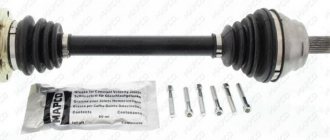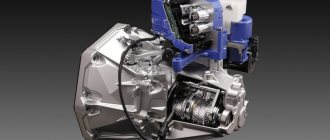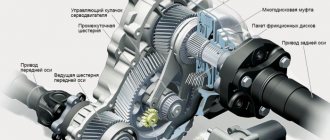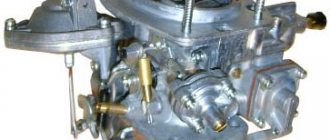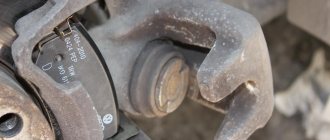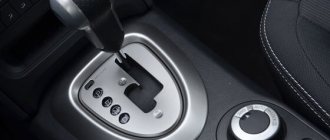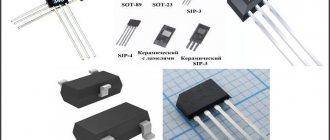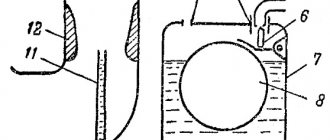The transmission allows you to change the torque supplied to the wheels from the engine. At first, a manual transmission (manual transmission) was used for this; much later, an automatic transmission (automatic transmission) appeared. One of the branches of the further development of automatic transmissions was a technology called tiptronic.
What is tiptronic in a car and how did it appear?
To drive a car in various modes, a transmission was created. It is thanks to it that torque is transmitted to the wheel group. Modern cars are equipped with manual and automatic transmissions. Car drivers who want to fully control the driving process choose a manual transmission, while others prefer an automatic transmission (automatic transmission).
In order for cars with automatic transmission to be able to control the dynamics during braking, turning, accelerating, and downshifting, the tiptronic function was added. Most car enthusiasts think that this is a separate device, which is represented by a new transmission. But this is a mistaken opinion.
Initially, the system was used for sports cars. The name was patented by Porsche, which released the first car with automatic transmission and manual gear control in 1990. Later, other enterprises began to use this innovation, calling it touchtronic, espatik, steptronic. The name tiptronic became the final version, which is still used today. The system has become actively used in robotic gearboxes, as well as CVTs. Today, this name more closely implies any automatic transmission that is provided with a manual gear shift adjustment function.
The service center carries out major repairs of automatic transmissions of Lexus domestic and foreign cars at affordable prices. We offer free diagnostics, car delivery at the company’s expense, prompt and accurate determination of the causes of the breakdown, as well as their complete elimination with a guarantee of up to 2 years. The website contains repair manuals for various automatic transmissions. Our advantages: Free tow truck, Warranty up to 2 years, Repair up to 2 days
Maintenance and life extension
Regular technical inspection and following the manufacturer's instructions allow a car with a Tiptronic automatic transmission to drive without problems for quite a long time. Ignoring problems that have arisen will cost you expensive repairs and make you a pedestrian for a while.
If you own a car with tiptronic, do not forget to promptly check it for problems and damage. Although this type of automatic transmission is durable, it is still not immortal. If you notice alarm bells (the gear shift time has increased, the car begins to twitch), contact a car service center. Regular inspection will not only help prevent serious damage, but will also give you the opportunity to enjoy driving.
Why is it needed in a car?
The task of these designs (initially) was practically the same - to make the car more sporty and spin the engine to higher speeds , which gives better dynamics; the automatic transmission in the normal “D” - drive mode will not allow you to do this, but here you are welcome. Moreover, under the steering paddles (gear shifts), they give you greater comfort without the need to pull away from the lever (that is, an imitation of a sequential gearbox).
Later, this manual mode was expanded, and now many people use it for improved off-road performance, for dealing with snow in yards, for traffic jams (you can put in second gear and push well in it, and the automatic transmission will not jump from gear to gear), even for fuel economy
How is Tiptronic useful?
To answer this question, it is worth examining the pros and cons of a gearbox equipped with a tiptronic function. By turning on the forced control mode, the car enthusiast receives the following bonuses:
- a feeling of complete control over the car, as with a manual transmission;
- the ability to accelerate sharply by manually shifting to a lower gear;
- fuel economy when coasting;
- engine braking when you consider it necessary;
- confidently towing another vehicle;
- overcoming small snow drifts and mud in a car not equipped with cross-axle differential locks and a stabilization system.
Dynamic acceleration with the engine spinning up to maximum speed is sometimes required to confidently overtake heavy trucks, especially when driving uphill.
A power unit with a displacement of up to 2 liters, operating in conjunction with an automatic transmission, does not immediately respond to pressing the accelerator. But the tiptronic automatic transmission can be forced down 1-2 gears and quickly accelerate by increasing the speed. The behavior of the automatic transmission when coasting cannot be called economical - in the process of slowing down the car on a descent, it automatically switches to lower gears and engine braking. Tiptronic allows you to forcefully “stick” the last gear and roll down the mountain longer, saving fuel. Conversely, the driver can apply engine braking at any time by turning on a lower speed.
Note. The Tiptronic system is protected against accidental incorrect shifting. If you mistakenly switch 2 steps down or up at once, the automation will correct the error and make one switch.
To overcome snow-covered roads in a regular passenger car, slippage is often required. A traditional automatic transmission will not allow the car to slip, as it will begin to shift to higher gears, resulting in the engine stalling. The tiptronic gearbox will not shift until the driver touches the selector lever or the crankshaft speed reaches the maximum.
The disadvantages of automatic transmissions equipped with tiptronic are obvious: greater weight of the unit, difficulty in repair and high initial price. Over the years, the last factor is losing relevance due to the introduction of high-tech simple solutions and lower product costs.
How to use the tiptronic box
To activate the manual shift function, do the following: Normally, the tiprotronic is controlled using the automatic transmission lever. But, some models may be equipped with steering column switches or buttons on the steering wheel.
- Move the gearshift lever to the right or left, then you can move the same lever back and forth, switching to an up or down gear.
- If the car is equipped with steering column switches or buttons marked “+” and “-”. Then you need to perform manual switching with their help.
If the driver does not use the tiptronic, the system will operate in automatic mode, like a regular automatic transmission.
Operating principle of tiptronic
The principle of operation of the tiptronic mode is as follows:
- The driver switches the selector lever to manual or tiptronic mode. Presses the unlock button. It protects the movement of the lever in automatic mode without turning it off.
- Selects the higher one. Torque increases gradually, like with a manual transmission. In this case, all gear numbers are strictly recorded in the machine’s ECU. The box will not be able to switch immediately from second to third, like with an automatic transmission. Then the driver shifts the car into a lower gear using the range selection lever in the tiptronic department.
- All tiptronic switching occurs conditionally at the driver's command. If in a car the choice of downshift and upshift can be made using the steering wheel paddles, then you need to switch the selector lever to control using manual mode. And you can switch speeds on tiptronics using paddles.
Attention! According to the manufacturers, the automatic transmission with tiptronic has a gentle mode for the engine.
In boxes with tiptronic there is a rigid connection between the wheels and the automatic transmission. Without it, this mode cannot exist. The planetary gears are additionally reinforced. All this is done through the operation of planetary gears connected in series. They help increase torque and carry high loads with ease.
Electrical tuning, thanks to which manufacturers have updated a conventional automatic machine, software allows the electronic control unit to carry out a whole algorithm of gear shift programs. And also, if the computer considers that switching speeds at the moment is not the best choice, the command will be ignored.
What is the difference between an automatic transmission and a tiptronic?
An automatic transmission is a type of car transmission that does not require direct participation of the driver in the process of shifting gears: they shift autonomously. The lever, located in place of the usual gear shift lever in cars with manual transmission, is called a selector and does not switch the gears themselves, but the operating modes of the box: it has positions P, R, N, D and L (respectively for parking, reverse, neutral, vehicle movement and forced “quiet running”, which is used for driving over difficult rough terrain);
The tiptronic automatic transmission is a more advanced and advanced version of the automatic transmission. Tiptronic, which has a more advanced design, implies the possibility of driver intervention in the gear shifting process; in addition to the mentioned operating modes characteristic of an “automatic”, there is an area with marks (+) and (-) on the selector. If you move the selector to this area, gears can be changed manually. In addition, tiptronic is more gentle on the engine - numerous sensors, information from which is transmitted to the tiptronic control unit, make it possible to adjust the gear shifting process depending on operating conditions and engine load. It is easy to see that tiptronic is significantly different from an automatic, although it is, in fact,
Negative aspects of a modified gearbox
- despite a number of advantages over a classic automatic transmission, in comparison with a manual transmission, the equipment loses because it cannot convey all the charm and completeness of the sensations from the mechanics;
- Among all types of gearboxes, manual transmission ranks first in fuel economy, Tiptronic second, and only third automatic transmission.
- carrying out preventive and repair work will be an order of magnitude higher than analogues. As practice shows, cars more than 7 years old have big problems with the transmission, especially the Tiptronic type due to severe wear of rubbing parts.
Pros and cons of Tiptronic automatic transmission
Essentially, the Tiptronic is an automatic transmission with manual control. But this is not an ordinary automatic transmission, it is still a fundamentally new gearbox, which, for example, unlike an automatic transmission, can be braked by the engine.
Tiptronic is effective in all conditions. For example, you can quickly downshift and thereby increase the car's dynamics. Automatic transmission cannot afford this. In addition, in unfavorable road conditions, you can select a lower gear in advance, which means you feel more confident on the road.
Cutaway view of a modern tiptronic
The Tiptronic mode in the automatic transmission provides the driver with more options when driving the vehicle.
In a Tiptronic box, switching to manual mode is absolutely safe; the electronic system will block all operating conditions unacceptable for the car. At the same time, when braking, the computer will automatically downshift and the vehicle will move from first gear.
What other positive aspects can be found in Tiptronic?
- Fuel economy.
- Improved vehicle dynamics.
But what about the minuses? Not many, but they are there!
- Complexity of design.
- The Tiptronic system increases the cost of automatic transmission.
Advantages of Tiptronic automatic transmission
As we have already said, today even cheap cars are equipped with Tiptronic gearboxes, and car enthusiasts willingly buy such cars. There are several reasons for this.
- Today, the Tiptronic automatic transmission costs no more than a conventional automatic transmission, and its durability and maintainability are also not inferior to the best automatic transmission models.
- Cars with Tiptronic automatic transmission are more economical than cars with conventional automatic transmission.
- In a car with a Tiptronic automatic transmission, the driver has more control over the car - you can always turn on manual mode if necessary, for example, for engine braking. When driving on slippery surfaces (ice, mud, etc.) this can be very useful.
- Cars with Tiptronic automatic transmission allow you to confidently overtake, accelerate and accelerate. By controlling the gear shift, the driver can always be sure that he has enough time and engine power to complete the maneuver. On cars with conventional automatic transmissions there is often no such confidence.
- The Tiptronic automatic transmission allows the car to feel more confident off-road and on rural country roads. Manual gear control allows you to save the resource of the gearbox and engine when driving on bad roads.
- If there is a winter operating mode, the Tiptronic automatic transmission allows you to move away from a stop in second speed, which allows you to avoid slipping on any surface, which is destructive for the automatic transmission.
- The Tiptronic automatic transmission is equipped with additional safety systems that monitor the driver’s actions in terms of gear shifting. Therefore, it is more difficult to damage such an automatic transmission by incorrect or careless gear shifts.
- The Tiptronic automatic transmission combines the ideal of a modern driver - the comfort of an automatic transmission, in which you do not need to constantly depress the clutch, and the sporty drive that is provided by the ability to independently change gears and determine the speed of acceleration and movement of the car yourself.
- Some modern semi-automatic automatic transmissions (for example, the same Steptronic from BMW) have an adaptive mode - they adapt to the driving style of a particular driver and allow you to get maximum pleasure and drive from the driving process.
- The most important advantage of the Tiptronic automatic transmission is the ability to choose. If you just want to enjoy a quiet ride, you use the fully automatic transmission mode. If you want some drive or think that it is better to take control of the gear shift, turn on the manual mode of the automatic transmission.
Types of gearboxes
Currently, the concept of an automatic transmission has become somewhat broader, since there are many types of it. Let's focus on two of them: classic and Tiptronic.
Classic automatic transmission
Classic automatic transmission
Without going into details, an automatic transmission is a gearbox in which speeds are switched automatically without driver intervention. But, in accordance with generally accepted engineering terminology, an automatic transmission is only a planetary part of the system that switches speeds.
Tiptronic
Tiptronic is the same automatic transmission that has the ability to change gears like a manual. The Tiptronic gearbox was first installed on a Porsche 911 in 1990, and a few years later they began to be equipped with BMW, Volkswagen, Audi and other cars. In normal mode, the box operates like a regular automatic transmission, but if necessary, it can be switched to mechanical mode at any time. This function makes it possible to bypass the computer and switch to direct manual control of the transmission.
Many drivers believe that this is not an independent type of gearbox, but only an additional automatic function.
Tiptronic is the best option for those car enthusiasts who want to combine the comfort of driving in automatic transmission mode and a sporty driving style.
Tiptronic box
Tiptronic has 4 or 6 speeds and the gearbox of this type operates very smoothly, any jerks are excluded. At speeds above the 1st hydraulic transformer is blocked, which ensures the transmission of torque virtually without any losses. A special program can analyze the road, outside temperature, engine and gearbox, and adapts to your personal driving style, thus calculating the best time to switch.
If you prefer manual gear shifting, then you only need one touch on the lever to move it forward to a higher speed or back to a lower speed. You do not need to depress the clutch pedal and there will be no loss of traction force. Changing speeds in manual mode is safe, since any erroneous shifts will be blocked. In case of braking, there is no need to shift the lever - the box itself will switch to low gear and then start from 1st speed.
Comparing tiptronic in an automatic and manual transmission
A manual transmission is known to many car enthusiasts with extensive driving experience. This type of gearbox invites the driver to directly participate in gear shifting, thereby fully controlling the control process, which is a plus. An obvious advantage over automatic transmission is that there is no need for a torque converter, which was created due to the impossibility of air cooling. The disadvantage of the mechanics is that in urban conditions there is little need to use it: there is nowhere to accelerate - there are either signs with traffic lights and traffic police posts all around, or traffic jams: it is difficult to stand in them for a long time, any movement requires changing gears. For some drivers, manual transmission does not provide unlimited possibilities, but on the contrary, it makes them distracted and prevents them from concentrating on the road.
It is worth mentioning another type that combines a manual transmission with an automatic one, but is developed on the basis of a manual transmission. We are talking about a robotic gearbox or “robot”. Perhaps the best example is Opel's development called Easytronic. The mechanical part was taken from the manual transmission; the automatic transmission is represented by an electronic unit, which is responsible for the clutch and independently decides when to shift gears.
Unfortunately, the good idea was poorly implemented. Jerks under load have become much more noticeable, sometimes switching on a new gear takes a lot of time, even with the gas pedal pressed all the way. This gearbox cannot change gears instantly (like a manual transmission), and smooth shifting (like an automatic transmission) is also absent. A car with a robot can only be used in city conditions, for a quiet, careful ride.
Changing automatic transmission gears: how to engage reverse gear on an automatic transmission or move forward
Today, for a number of reasons, automatic transmission is a much more preferable option than manual transmission. This is especially true if the car is constantly used in a metropolitan area, where traffic in heavy traffic is characterized by low speeds, frequent accelerations and stops, as well as moving and idling in traffic jams.
Given this popularity, many novice drivers, as well as those who previously drove a car with a manual transmission, are actively switching to cars with an automatic transmission. Next, we will look at how to change gears on an automatic transmission, what you need to know about automatic transmission modes, and also how to engage reverse gear on an automatic transmission.
How to shift gears on an automatic transmission
Among these main modes are:
- R- parking, parking;
- R - reverse gear;
- N-neutral;
- D - drive, forward movement;
- M - manual control mode;
Park mode allows you to start the engine, after which the engine idles (for example, during warm-up). It is also recommended to leave the car parked in this mode.
It is noteworthy that after turning on “P” the automatic transmission shaft locking is also activated. This blocking prevents the car from rolling and is an additional “insurance”.
Mode “R” is responsible for reverse gear and is activated only after the car has come to a complete stop. Ignoring this rule may cause serious damage to the gearbox.
The “N” mode, unlike the “P” mode, allows you to separate the transmission and the engine, and this mode does not have any additional locks (as in the case of “parking”).
You can also turn on the “N” mode in a traffic jam, when the car has been standing for a long time (more than 10 minutes) and the engine is running, but you need to remember that in this case you need to additionally use the handbrake (parking brake) or hold the car with the brake pedal, otherwise the car may start rolling randomly.
Mode “D” allows you to move forward, gears change automatically. No additional action is required from the driver; all that remains is to press the gas to accelerate and the brake to slow down or come to a complete stop.
- The gear shift lever itself (automatic transmission selector) on different cars with an automatic transmission, regardless of the type, often simply moves along special grooves. Each slot corresponds to a separate mode (as a rule, there are symbols next to the slot; also, the selected modes on most cars are duplicated on the dashboard).
What to choose
When choosing between an automatic transmission and an automatic transmission equipped with tiptronic, it is better to give preference to the latter. This device has a lot of advantages and a small number of disadvantages. In terms of functionality, it is significantly ahead of the classic automatic transmission. Moreover, on Russian roads, joint control of mechanics and automation is more acceptable. It is more modern and more economical. Creates more convenience and comfort for the driver.
The classic automatic transmission is more suitable for beginners without driving experience. Thanks to full automation, you can concentrate on the road and not be distracted by switching modes. It is especially convenient and comfortable to drive on city roads in automatic mode. When driving through hard-to-reach places, it cannot withstand and breaks.
Advantages of a classic automatic transmission
Advantages of a classic automatic transmission
- A classic automatic is much more convenient for a beginner - you don’t have to worry about additional operating modes or losing torque due to untimely engagement of a gear in manual mode.
- An automatic is much cheaper than a tiptronic, which significantly affects the cost of the car itself.
- Repairing a tiptronic is much more expensive than a regular automatic transmission. Even tiptronic diagnostics are more complicated - there are an abundance of elements that provide more comfortable switching and greater dynamics.
- The design of an automatic transmission has long been known to all car enthusiasts, which allows, in some cases, to repair the gearbox not in specialized car repair shops, but from familiar specialists.
- An automatic transmission is convenient for drivers who prefer a calm and measured type of driving (in principle, tiptronic also provides this opportunity).
- An automatic transmission weighs much less.
- When driving around the city, automatic transmission allows you to significantly save fuel due to the human factor - in the city it is more convenient to use the manual operating mode of the tiptronic, which implies greater dynamics, but also higher consumption.
Breakdowns and repairs
Nothing is perfect and the tiptronic gearbox is no exception. The design of this gearbox is slightly different from a standard automatic transmission. Tiptronic requires proper operation and proper care. Sometimes even correct use cannot protect the box from problems. The most common tiptronic problems are:
- Malfunction of the electronic control unit;
- Problems with oil;
- Mechanical breakdowns, wear of parts (for example, oil seal, oil pump).
Auto service employees can help resolve most of these problems.
Self-repair is not recommended - even filling the tiptronic with oil is sometimes not so easy, let alone replacing parts. At best, an attempt to repair the box will not be successful; at worst, it will render the car inoperable.
What kind of oil is used to fill Tiptronic?
If the car owner cannot find a manual for the transmission, then he can find out from the experienced mechanics of the service center. There is also the opportunity to contact the dealership. They will tell you what oil you will need to replace the used fluid in an automatic transmission with tiptronic.
If you don’t have the original, it is recommended to purchase analogues in viscosity that are not inferior to the oil from the manufacturer. And also all technical parameters must match.
How long does it take to change the oil?
Experts advise completely changing the oil in an automatic transmission with tiptronic when operating in extreme conditions after 60 thousand kilometers, and doing a partial change after 30 thousand kilometers. Severe conditions for an automatic transmission include:
- cold or hot seasons with extremely low or high temperatures;
- standing in traffic jams for up to two to three hours a day;
- driving on dirt and country roads;
- towing other vehicles or cargo.
It is especially important to monitor the oil while towing and prevent overheating. After towing a heavy load for a long time, experts advise doing a complete lubricant change.
The need for diagnostic and repair work
The main reason for problems with the functioning of the preselective gearbox is the lack of proper care on the part of the driver. Its maintenance is expensive for the car owner. As the component parts of the gearbox wear out, extraneous sounds and noises will begin to be heard from its side. As a rule, these manifestations are clearly noted when moving from medium to higher speeds.
When the vehicle is actively used in difficult conditions over rough terrain, increased fuel consumption may soon be observed against the backdrop of a slower response to speed changes. Repair of S-Tronic in this case is required. Its diagnosis should be carried out using specialized programs and equipment. Thanks to this, it is possible to accurately determine the nature of the existing problem. After this, you can begin to remove the box and troubleshoot it.
A car with such a gearbox requires regular oil changes. This procedure is usually carried out every 40,000 (50,000) km. In this case, it is necessary to remove the crankcase protection, unscrew the drain plug, then place an empty container into which the spent transmission fluid will drain. Fuel is added through the breather using a filling syringe. You should use original types of oils with optimal viscosity.
Clutch replacement may be necessary after 30,000 km. To do this you need to dismantle the box. You should arm yourself with a set of tools for removing the clutch. All shafts need to be checked. As a rule, if the clutch is broken, this causes jerking and characteristic vibrations. It is recommended to purchase branded spare parts necessary to repair the box (filter element, pan gasket, etc.).
Differences between tiptronic automatic transmission and CVT
The need for an automatic transmission arose when, in urban traffic conditions, it was necessary to increase the level of comfort for drivers. They no longer had to be distracted by controlling the gears; the ECU did everything for them. However, there were still situations where it was necessary to manually change gear. Therefore, for some motorists, the automatic was rather a hindrance.
A CVT is a type of automatic transmission. But there is a big difference between it and tiptronic, since the variator is a continuously variable transmission. It allows the car to accelerate smoothly, with no jerking, twitching or dips.
Compared to a tiptronic, a variator has a big disadvantage, which is the load transmission link. Most CVT transmissions have belts installed that are responsible for selecting the optimal travel mode. They wear out quickly if drivers don't follow car manufacturers' recommendations. The CVT requires careful driving and limiting loads. It is forbidden to allow severe slipping, transport heavy loads, or use trailers.
conclusions
In a word, for all the positive qualities of tiptronic you will have to pay with higher financial costs when purchasing. However, the costs of the machine can be much higher if it is used incorrectly. If your financial situation does not allow you to purchase a tiptronic, you like a measured and smooth ride, or you just want to gain experience in driving and then change your car, an automatic is a completely acceptable option. It is advisable to take a car with tiptronic if you plan to use this vehicle for a long period of time, in which case the investment will pay off handsomely both in terms of driving convenience and in terms of maintenance.
